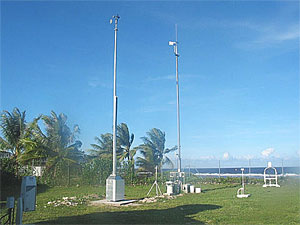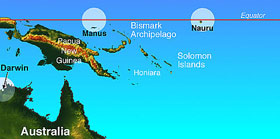 Tropical Western Pacific
Tropical Western Pacific
Manus, Papua New Guinea: 2.006° S, 147.425° E, 6m MSL
Nauru Island: 0.521° S, 166.916° E, 7.1m MSL
Darwin, Australia: 12.425° S, 130.891° E, 29.9m MSL

The Tropical Western Pacific (TWP) locale was established in 1996 as the second ARM Climate Research Facility site. Operated by the Tropical Western Pacific Office (TWPO) at Los Alamos National Laboratory, the TWP site consists of three climate research facilities: the Manus facility on Los Negros Island in Manus, Papua New Guinea (established in 1996); the Nauru facility on Nauru Island, Republic of Nauru (1998); and the Darwin facility in Darwin, Northern Territory, Australia (2002). The operations are supported by government agencies in each host country.
Covering the area roughly between 10° N and 10° S of the equator and from 130° E to 167° E, the TWP locale includes a region that plays a large role in the interannual variability observed in the global climate system. For example, a phenomenon called the El Niño/Southern Oscillation, or ENSO, has far-reaching implications for weather patterns over much of the Northern Hemisphere and perhaps the entire planet.

In addition, the TWP region consistently has the warmest sea-surface temperatures and is often called the Pacific "warm pool." This warm body of water supplies heat and moisture to the atmosphere above it, causing the formation of deep convective cloud systems that produce high-altitude cirrus clouds. These cloud systems affect the amount of solar energy reaching the surface of the Earth as well as the amount of heat energy that can escape into space.
The Manus, Nauru, and Darwin facilities collect continuous climatic data that will help better understand the interactions between clouds and incoming and outgoing energy. Those data will ultimately help improve the general circulation models used in climate studies.



